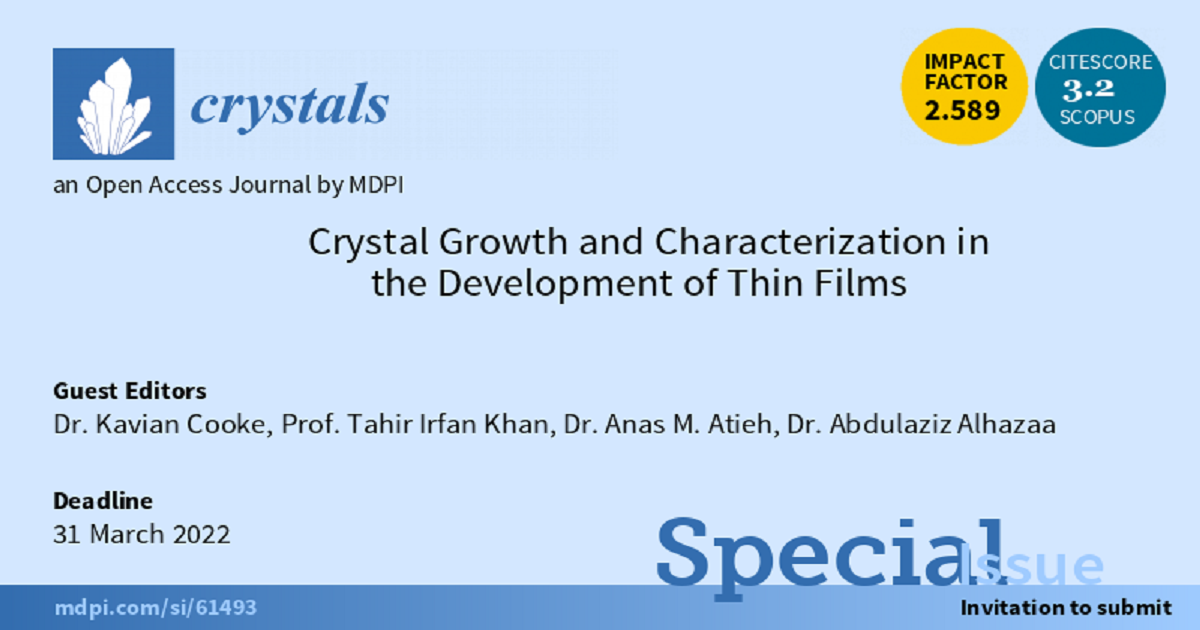Crystal Growth and Characterization in the Development of Thin Films
A special issue of Crystals (ISSN 2073-4352). This special issue belongs to the section "Crystal Engineering".
Deadline for manuscript submissions: closed (31 March 2022) | Viewed by 8648

Special Issue Editors
Interests: nanomaterials; welding and joining; solidification; thin films; coatings
Interests: Microstructural characterization; Diffusion bonding; Nanostructured coatings; Surface modification; Tribology
Special Issues, Collections and Topics in MDPI journals
Interests: manufacturing; production; materials science and engineering
Special Issue Information
Dear Colleagues,
The aim of this Special Issue "Crystal Growth and Characterization in the Development of Thin Films" is to address current challenges in crystal growth for surface engineering and tribology applications.
For this issue, we invite contributions from researchers working in areas of crystal growth and the development of novel thin films, epitaxy, interface and surface analysis, surface characterization, tribological characterization, the study of relevant properties (including morphology, physical, chemical, optical, self-healing, etc.), and growth materials (thin films and nanostructure). Research may also include process optimization of the parameters describing crystal structure and innovative application of crystal growth technology and thin films.
Considering your outstanding contributions in this fascinating research field, I would like to cordially invite you to submit a paper to this Special Issue.
Dr. Kavian Cooke
Prof. Tahir Irfan Khan
Dr. Anas M. Atieh
Dr. Abdulaziz Alhazaa
Guest Editors
Manuscript Submission Information
Manuscripts should be submitted online at www.mdpi.com by registering and logging in to this website. Once you are registered, click here to go to the submission form. Manuscripts can be submitted until the deadline. All submissions that pass pre-check are peer-reviewed. Accepted papers will be published continuously in the journal (as soon as accepted) and will be listed together on the special issue website. Research articles, review articles as well as short communications are invited. For planned papers, a title and short abstract (about 100 words) can be sent to the Editorial Office for announcement on this website.
Submitted manuscripts should not have been published previously, nor be under consideration for publication elsewhere (except conference proceedings papers). All manuscripts are thoroughly refereed through a single-blind peer-review process. A guide for authors and other relevant information for submission of manuscripts is available on the Instructions for Authors page. Crystals is an international peer-reviewed open access monthly journal published by MDPI.
Please visit the Instructions for Authors page before submitting a manuscript. The Article Processing Charge (APC) for publication in this open access journal is 2100 CHF (Swiss Francs). Submitted papers should be well formatted and use good English. Authors may use MDPI's English editing service prior to publication or during author revisions.
Keywords
- grain growth
- grain size
- nucleation
- solid-state structures
- microstructural characterization
- wear testing
- friction
- tribology
- mechanical testing
- crystal growth
- perovskite
- epitaxial growth
Benefits of Publishing in a Special Issue
- Ease of navigation: Grouping papers by topic helps scholars navigate broad scope journals more efficiently.
- Greater discoverability: Special Issues support the reach and impact of scientific research. Articles in Special Issues are more discoverable and cited more frequently.
- Expansion of research network: Special Issues facilitate connections among authors, fostering scientific collaborations.
- External promotion: Articles in Special Issues are often promoted through the journal's social media, increasing their visibility.
- e-Book format: Special Issues with more than 10 articles can be published as dedicated e-books, ensuring wide and rapid dissemination.
Further information on MDPI's Special Issue polices can be found here.







